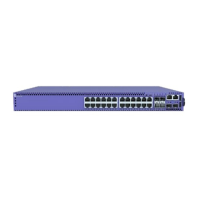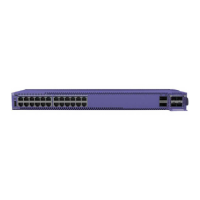Label Cables and Keep Accurate Records
A reliable cable labeling system is essential when planning and installing a network.
Keeping accurate records helps you to:
• Relocate devices easily.
• Make changes quickly.
• Isolate faults in the distribution system.
• Locate the opposite end of any cable.
• Know the types of network devices that your cabling infrastructure can support.
Follow these guidelines when setting up a cable labeling system suitable for your
installation:
• Identify cables by securely attaching labels to all cable ends.
• Assign a unique block of sequential numbers to the group of cables that run
between each pair of wiring closets.
• Assign a unique identication number to each equipment rack.
• Identify all wiring closets by labeling the front panel of your Extreme Networks
equipment and other hardware.
• Keep accurate and current cable identication records.
• Post records near each equipment rack. For each cable drop, include information
about the cable source, destination, and jumper location.
Install Cable
When you connect cable to your network equipment, keep the following things in
mind.
• Examine cable for cuts, bends, and nicks.
• Support cable using a cable manager that is mounted above connectors to avoid
unnecessary weight on the cable bundles.
• Use cable managers to route cable bundles to the left and right of the network
equipment to maximize accessibility to the connectors.
• Provide enough slack, approximately 5 to 7.5 cm (2 to 3 in), to provide proper strain
relief as shown in Figure 30 on page 47.
• Bundle cable using hook-and-loop straps to avoid injuring cables.
• If you build your own cable, be sure that connectors are properly crimped.
• When installing a patch panel using twisted pair wiring, untwist no more than 2.5
cm (1 in) of the cable to avoid radio frequency (RF) interference.
• Discharge the RJ45 Ethernet cable before plugging it into a port on the switch.
Caution
Unshielded twisted pair (UTP) cable can build up electrostatic charges when
being pulled into a new installation. Before connecting any category 5 UTP
cable to the switch, discharge ESD from the cable by plugging the RJ45
connector into a LAN static discharge device or use an equivalent method.
Label Cables and Keep Accurate Records Site Preparation
46 ExtremeSwitching 5420 Series Hardware Installation Guide

